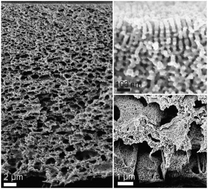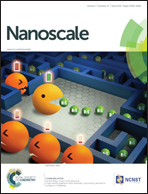Graded porous inorganic materials derived from self-assembled block copolymer templates†
Abstract
Graded porous inorganic materials directed by macromolecular self-assembly are expected to offer unique structural platforms relative to conventional porous inorganic materials. Their preparation to date remains a challenge, however, based on the sparsity of viable synthetic self-assembly pathways to control structural asymmetry. Here we demonstrate the fabrication of graded porous carbon, metal, and metal oxide film structures from self-assembled block copolymer templates by using various backfilling techniques in combination with thermal treatments for template removal and chemical transformations. The asymmetric inorganic structures display mesopores in the film top layers and a gradual pore size increase along the film normal in the macroporous sponge-like support structure. Substructure walls between macropores are themselves mesoporous, constituting a structural hierarchy in addition to the pore gradation. Final graded structures can be tailored by tuning casting conditions of self-assembled templates as well as the backfilling processes. We expect that these graded porous inorganic materials may find use in applications including separation, catalysis, biomedical implants, and energy conversion and storage.


 Please wait while we load your content...
Please wait while we load your content...